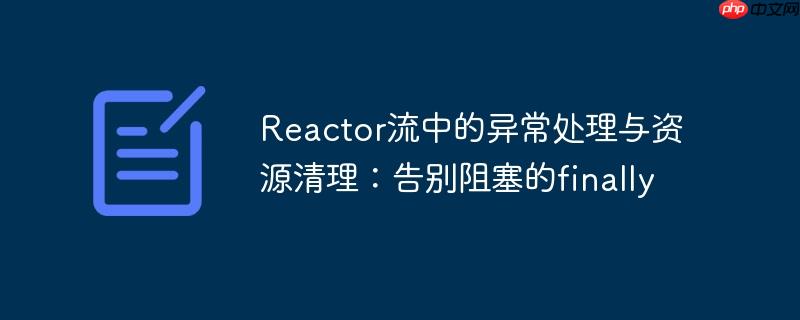
在传统的命令式编程中,try-catch-finally结构是处理异常和确保资源清理的基石。然而,当我们将这种模式直接移植到Project Reactor等响应式框架中时,会遇到兼容性问题。响应式流是异步且非阻塞的,而finally块中的操作通常是同步且阻塞的。在一个响应式链中执行阻塞操作会严重损害其非阻塞特性,导致线程阻塞,影响系统吞吐量和响应速度。
此外,在Reactor中,不应直接抛出异常(throw new RuntimeException(...)),因为这会中断流的执行并跳过后续的响应式操作符。Reactor通过特殊的“错误信号”(error signal)来传播异常,这要求我们使用特定的操作符来处理这些信号。
Reactor中的Mono和Flux都内置了错误信号的概念。当流中发生错误时,它会发出一个错误信号并终止。为了捕获和处理这些错误,Reactor提供了一系列专用的操作符:
原先在finally块中执行的资源清理或状态保存操作,在响应式编程中需要被分解并整合到流的成功和错误路径中。这通常意味着需要在两个地方显式处理这些副作用:
让我们通过一个具体的例子来演示如何重构代码,使其符合Reactor的非阻塞和错误处理范式。
原始的命令式逻辑(存在阻塞问题):
public Mono<Response> process(Request request) {
var existingData = repository.find(request.getId()); // 假设是阻塞的
if (existingData != null) {
if (existingData.getState() != pending) {
throw new RuntimeException("test"); // 直接抛出异常
}
} else {
existingData = repository.save(convertToData(request)); // 假设是阻塞的
}
try {
var response = hitAPI(existingData); // 假设是阻塞的
} catch(ServerException serverException) {
log.error("");
throw serverException;
} finally {
repository.save(existingData); // 阻塞的finally操作
}
return convertToResponse(existingData, response);
}重构为响应式、非阻塞的Reactor风格:
假设repository是一个响应式仓库(返回Mono或Flux)。
import reactor.core.publisher.Mono;
import org.slf4j.Logger;
import org.slf4j.LoggerFactory;
public class ReactiveProcessor {
private static final Logger log = LoggerFactory.getLogger(ReactiveProcessor.class);
private final ReactiveRepository repository; // 假设这是一个响应式仓库
public ReactiveProcessor(ReactiveRepository repository) {
this.repository = repository;
}
// 示例接口和类,实际应根据业务定义
interface Request { String getId(); }
interface Response {}
interface Data { String getState(); }
enum State { PENDING, COMPLETED } // 假设有PENDING状态
// 模拟的响应式仓库接口
interface ReactiveRepository {
Mono<Data> find(String id);
Mono<Data> save(Data data);
}
// 模拟的外部API调用
private Mono<Response> hitAPI(Data data) {
// 假设这是一个返回Mono的非阻塞API调用
// 如果是阻塞的,应使用 Mono.fromCallable 或 Mono.fromRunnable 包裹
return Mono.just(new Response() {}); // 示例
}
private Data convertToData(Request request) {
// 转换逻辑
return new Data() { @Override public String getState() { return State.PENDING.name(); } };
}
private Response convertToResponse(Data data, Response apiResponse) {
// 转换逻辑
return new Response() {};
}
public Mono<Response> process(Request request) {
return repository.find(request.getId())
// 1. 处理现有数据或创建新数据
.flatMap(existingData -> {
// 如果找到数据且状态不为PENDING,则发出错误信号
if (existingData.getState().equals(State.COMPLETED.name())) { // 假设COMPLETED是需要抛错的状态
return Mono.error(new RuntimeException("Data state is not pending."));
} else {
// 否则,返回现有数据
return Mono.just(existingData);
}
})
// 2. 如果find结果为空(switchIfEmpty),则保存新数据
.switchIfEmpty(Mono.defer(() -> repository.save(convertToData(request))))
// 3. 执行API调用并处理其结果及副作用
.flatMap(existingData ->
Mono.fromCallable(() -> { // 使用fromCallable包装可能阻塞的hitAPI(尽管这里假设hitAPI是响应式的)
// 实际业务中,hitAPI通常返回Mono,无需fromCallable
return hitAPI(existingData).block(); // 示例:模拟阻塞调用并立即阻塞,实际应避免
})
.flatMap(apiResponse -> {
// 成功路径:保存数据,然后转换为响应
return repository.save(existingData) // 模拟finally中的保存操作 (成功时)
.map(updatedData -> convertToResponse(updatedData, apiResponse));
})
// 4. 错误处理:记录日志并执行finally逻辑
.doOnError(ServerException.class, throwable -> log.error("API call failed: {}", throwable.getMessage(), throwable))
.onErrorResume(throwable ->
// 错误路径:保存数据,然后重新发出原始错误
repository.save(existingData) // 模拟finally中的保存操作 (错误时)
.then(Mono.error(throwable)) // 确保原始错误被重新传播
)
);
}
}代码解析:
通过遵循这些原则和使用正确的Reactor操作符,我们可以构建出高效、健壮且完全非阻塞的响应式应用程序,优雅地处理异常和管理资源。
以上就是Reactor流中的异常处理与资源清理:告别阻塞的finally的详细内容,更多请关注php中文网其它相关文章!

每个人都需要一台速度更快、更稳定的 PC。随着时间的推移,垃圾文件、旧注册表数据和不必要的后台进程会占用资源并降低性能。幸运的是,许多工具可以让 Windows 保持平稳运行。

Copyright 2014-2025 https://www.php.cn/ All Rights Reserved | php.cn | 湘ICP备2023035733号